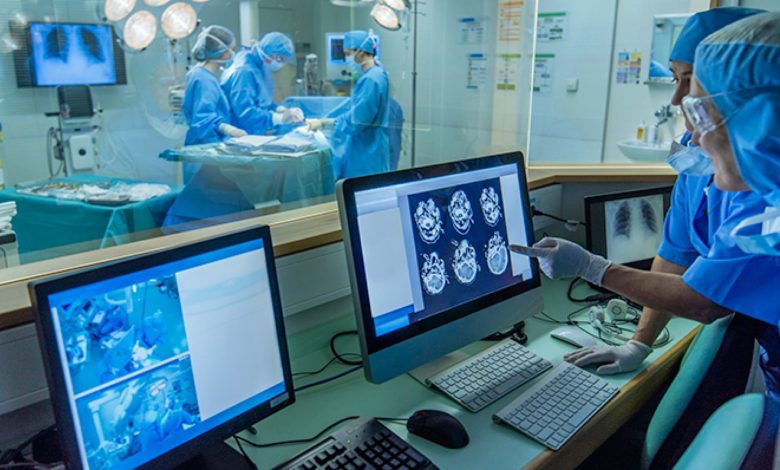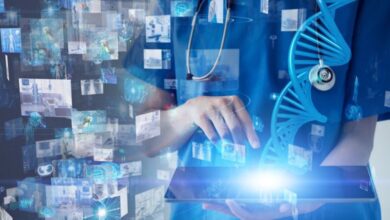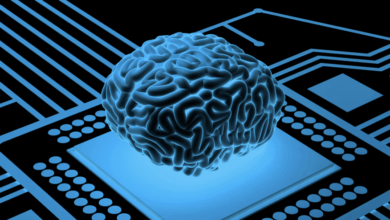
Times of crisis prompt us to rethink the infrastructure and institutions that we have long taken for granted, and the onset of COVID-19 has been no different. The pandemic has revealed critical areas of vulnerability in our essential systems and has accelerated the uptake of new technologies, as we strive to do things more efficiently and safely. However, no sector stands more to gain from new technologies and artificial intelligence (AI) than healthcare.
Across the world, hospitals have felt the strain of COVID-19, overwhelmed with the sheer volume of patients needing care. With cases threatening to submerge healthcare systems, providers were forced to rapidly adapt and look to emerging technologies to meet unprecedented and urgent demands. Indeed, over the last few months, we have seen a proliferation of AI, digital tools, and revolutionary technology across all elements of our COVID-19 response designed to improve our ability to detect infection, monitor and visualise the spread of the virus, as well as enhance medical treatment and boost drug discovery.
Forecasting and pattern detection
AI has been championed for playing an integral role in helping identify the initial outbreak of the virus and monitoring its spread. On December 30, 2019, an AI platform BlueDot detected a cluster of “unusual pneumonia” cases occurring around a market in Wuhan, China, and sent out an outbreak alert to public health authorities. Following this, scientists have used interactive real-time maps and sophisticated algorithms to predict where the virus will spread, when it will occur and even forecast how fast it might travel. Various contract tracing apps which have been developed rely on AI to sift through large quantities of data and accurately identify if an individual has come into contact with a COVID-19 carrier.
Analysis and diagnosis
AI has also facilitated rapid diagnosis and risk analysis of COVID-19. Tech giant Alibaba developed an AI system which can detect COVID-19 through chest CT scans in just 20 seconds, compared to the usual 15 minutes it takes a medical professional. Another example is Infervision, a Beijing based AI company, which launched an AI solution specifically designed to help clinicians detect and monitor COVID-19, using an algorithm to locate the virus on images of patients’ lungs, and help healthcare professionals make quick and informed judgements.
Vocalis Health, a company pioneering AI-based vocal biomarkers for use in healthcare, repurposed its expertise in voice analysis and is now using its AI proprietary platform to detect unique acoustics in a person’s voice and determine if they are a high-risk individual and vulnerable to contracting the virus. The non-invasive test will be used to inform officials who may be in greatest need of testing, treating or isolating, and could significantly alleviate pressure on health systems.
Drug discovery and treatment
In the early stages of the pandemic, Google’s DeepMind used AI to predict the structure of proteins of the virus based on its genetic sequence and released its projections to the wider scientific community to aid research efforts. Another interesting example is BenevolentAI, a UK AI-drug discovery company, which used AI to examine the efficacy of all existing approved drugs against COVID-19, narrowing down the 6 most effective medications for treatment within a month.
This week, Moderna announced a vaccine candidate that was found to be almost 95% effective in preventing COVID-19 in participants, following Pfizer’s announcement of a potential vaccine last week. This news restores hope that vaccines can help end the pandemic, with the companies now planning to apply for emergency approval to enable the vaccine to be administered before Christmas. Both companies used a highly innovative and experimental approach to design the vaccines. Pfizer is known for using automation, AI and predictive analysis in its drug research and development process to analyse vast quantities of data with precision, and has created some impressive innovations using these technologies. For instance, last month Pfizer and IBM announced that they have developed a new AI model that can analyse clinical verbal tests to predict the onset of Alzheimer’s disease years before standard symptoms develop.
Preparing for life after COVID-19
2020 began with an announcement by Google’s health research unit that it had built AI which could outperform radiologists in detecting certain types of breast cancer, and the end of the year could potentially see the distribution of a COVID-19 vaccine, developed in under a year. These incredible medical feats show just how far our healthcare systems have come and how technology can support efforts to tackle new challenges.
In 2018, the World Health Assembly approved a resolution to prioritise the “development, evaluation, implementation, scale-up and greater utilisation of digital technologies, as a means of promoting equitable, affordable and universal access to health for all.” Two years later, we can see that the use of AI in the healthcare sector is increasingly sophisticated and increasingly prevalent, and it comes as no surprise to me that analysts forecast the Healthcare AI Market to grow at a CAGR of 41.4% from this year, and be worth US$51 billion by 2027. Investors, like myself, tech experts and healthcare experts alike are quickly becoming more confident in the integration of AI in the medical field, including its use in common healthcare issues as well as emerging threats.
AI is by no means a panacea for the issues facing our healthcare sectors worldwide. Healthcare transformations must go beyond the adoption of health technologies, and all stakeholders across the sector need to unite and make a concerted effort to implement the required regulatory infrastructure to integrate practical new technologies into everyday practice. Although the development and use of AI must be accompanied by robust governance and regulatory mechanisms, I hope to see greater trust in this new technology, and hope governments will help create an enabling environment to support its advancement and wider application.




